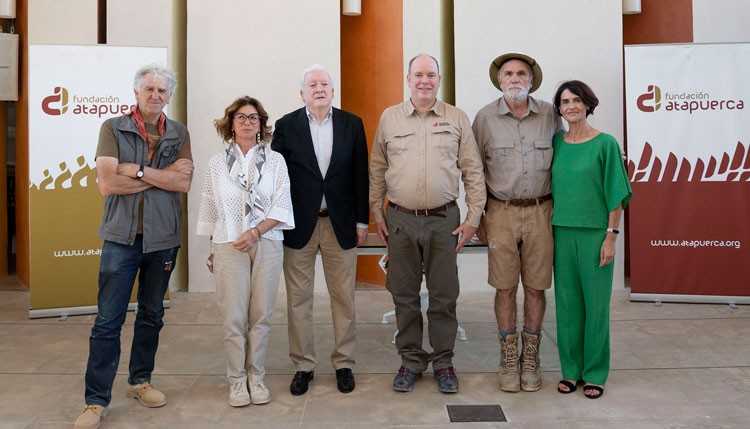The Diplomat
Last Tuesday, Prince Albert II of Monaco visited the Atapuerca archaeological sites and the headquarters of the Foundation in Ibeas de Juarros (Burgos), together with the Ambassador of Monaco, Catherine Fautrier Rousseau.
Prince Albert II was received by the co-directors of the Atapuerca Project and vice-presidents of the Foundation, Professors Juan Luis Arsuaga and Eudald Carbonell. The visit began at the site of El Portalón de Cueva Mayor, where the co-directors explained to the Prince the most important aspects of the sites that form part of this complex. They then visited the site of the Sima del Elefante, where this year the oldest face found to date in Western Europe was discovered. To end the visit to the sites, they went to Cueva Fantasma, a site with great potential for the study and knowledge of the life of the Neanderthals.
Afterwards, the visitors went to the headquarters of the Atapuerca Foundation, which was celebrating its 23rd anniversary, where Albert II of Monaco and Ambassador Catherine Fautrier were received by its president, Antonio M. Méndez Pozo. These sites,” said the Prince of Monaco, “make it possible to reconstruct the whole history of the people of Europe and what they were like in prehistoric times.
Given his interest in science, Prince Albert II of Monaco made this visit on a private basis. The Prince, like his ancestor Prince Albert I, is also an adventurer, a great traveller, a fierce defender of the environment and shows a great sensitivity for archaeology. The French professor Henry de Lumley, teacher of Professor Eudald Carbonell and a personal friend of the Monegasque sovereign, took part in this visit. De Lumley is the president of the Institute of Human Palaeontology in Paris – Prince Albert I Foundation – and in 2015 he received the Evolution Award from the Atapuerca Foundation for his scientific career. It should also be noted that Juan Luis Arsuaga is a member of the advisory committee of the Museum of Anthropology of Monaco.
After his visit to the Atapuerca Sites and the Atapuerca Foundation, Prince Albert II travelled to the city of Burgos to visit the Museum of Human Evolution (MEH) and the National Centre for Research on Human Evolution (CENIEH).
The Atapuerca Foundation was created with the aim of supporting the great Atapuerca Project, both in its research and socialisation work. Today it is a dream come true, and today it is a world reference in the knowledge of human evolution.






